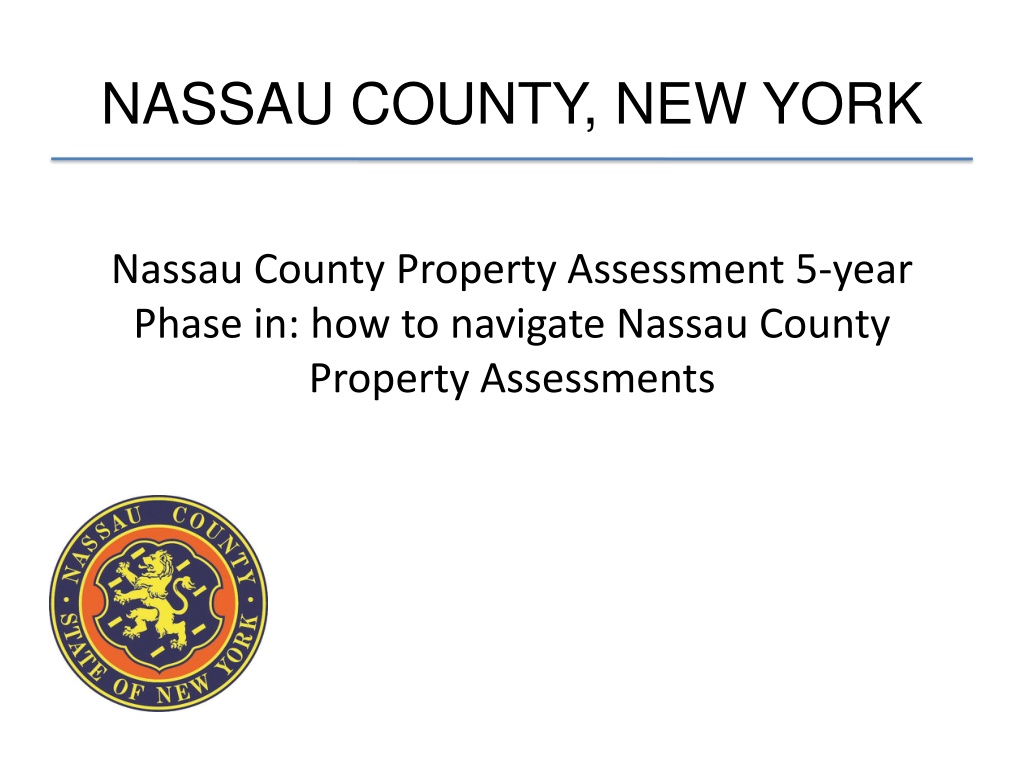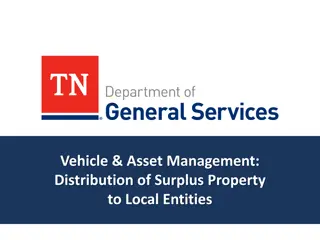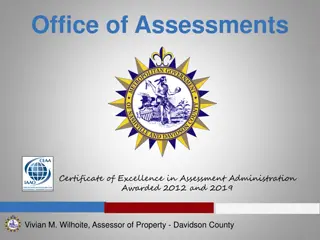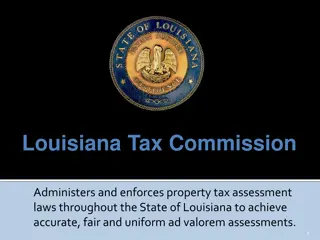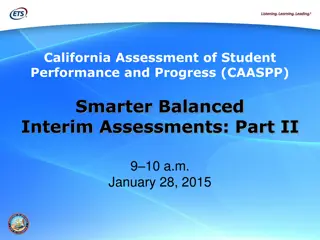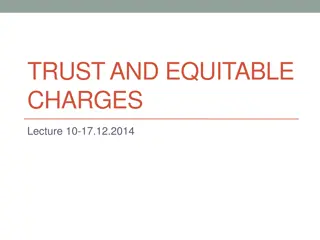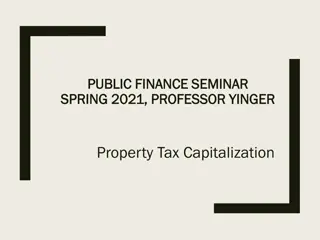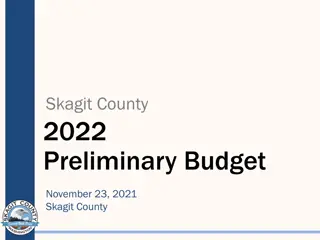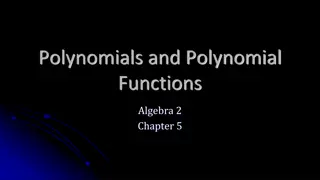Nassau County Property Assessments Overview
The Nassau County Department of Assessment oversees valuing a large number of residential and commercial parcels, implementing a reassessment in 2018 to address inaccuracies and disparities in property values. The Taxpayer Protection Plan (TPP) was introduced to phase in assessment increases over five years, maintaining fairness and stability in property taxes.
Download Presentation

Please find below an Image/Link to download the presentation.
The content on the website is provided AS IS for your information and personal use only. It may not be sold, licensed, or shared on other websites without obtaining consent from the author.If you encounter any issues during the download, it is possible that the publisher has removed the file from their server.
You are allowed to download the files provided on this website for personal or commercial use, subject to the condition that they are used lawfully. All files are the property of their respective owners.
The content on the website is provided AS IS for your information and personal use only. It may not be sold, licensed, or shared on other websites without obtaining consent from the author.
E N D
Presentation Transcript
NASSAU COUNTY, NEW YORK Nassau County Property Assessment 5-year Phase in: how to navigate Nassau County Property Assessments
Assessment Overview The Nassau County Department of Assessment is responsible for valuing approximately 420,000 parcels (380,000 residential and 40,000 commercial). Nassau County is the second largest assessing jurisdiction in the state behind New York City and assesses its properties as a special assessing unit based upon a complex four-class system, like New York City. Nassau County assesses property for itself and for the towns, special districts and all but one of the school districts in the County (approximately 300 taxing jurisdictions). It is one of only two counties in the state responsible for assessments. Cities and villages in Nassau County assess property for city and village purposes, respectively, and the City of Glen Cove assesses property for the Glen Cove City School District. Unlike most of the rest of the state, towns in Nassau have no assessing power.
Reassessment In 2018, Nassau County Executive Laura Curran directed the County Department of Assessment to perform the first reassessment in nearly a decade, reassessing both residential and commercial properties. Prior to the reassessment, many Nassau County property values were not based upon the actual market and were generally underassessed. The frozen assessment roll created wide disparities among taxpayers due to inaccurate assessments. The County restored equity and fairness to the assessment roll by accurately reassessing properties starting with the 2020-2021 assessment roll. The new assessment roll surpassed state and national assessment standards of accuracy.
Taxpayer Protection Plan (TPP) The 2020-2021 reassessment added billions of dollars of missing market value to the assessment roll, correcting years of degradation. Due to the necessary recapture of the increase in market value from the frozen assessment years, the County Executive proposed the Taxpayer Protection Plan (TPP) to avoid significant swings in taxes and maintain the thriving real estate market. The County enacted a local law in March 2020 to implement the plan based on state authorizing legislation. The TPP is a five-year exemption that phases in assessment increases due to the reassessment. The exemption base amount is the difference between the 2019-2020 final assessment and the 2020-2021 tentative assessment. The law equalizes the level of assessment between the two rolls for purposes of the exemption calculation. The exemption amount was 80% beginning on the 2020-2021 roll and will be decreasing by 20% increments for the subsequent four years, with the total increase becoming fully taxable by the fifth and final year. Assessment decreases and physical changes were excluded from the exemption.
TPP Example The equalized final 2019-2020 assessment was $250 (based on a $250,000 market value) The tentative 2020-2021 assessment was $500 (based on a $500,000 market value) The difference between the two assessments is $250 Remember, the exemption is for five years, and the initial exemption is 80% of the assessment increase. Therefore, only 20% of the increase is applied to the 2020-2020 tax year. $250 x 20%= $50 per year Example: $500 - $250 = $250 $250,000 x 20% = $50,000 Year 1: Year 2: Year 3: Year 4: Year 5: $300 $350 $400 $450 $500
New Exemption: RPTL Section 421-f Amendments In April 2021, the State enacted amendments to the Section 421-f of the Real Property Tax Law, as requested by County Executive Curran. The amendments will protect taxpayers against drastic property tax increases from qualifying new construction and home improvements and will help the local economy recover from the COVID-19 pandemic by stimulating the local construction industry. The amendments provide Nassau homeowners with an eight-year exemption for new construction and improvements that first appear on the County s 2021-2022, 2022-2023, 2023-2024 and 2024-2025 assessment rolls. Exception: new construction and improvements occurring in 2018 receive the exemption beginning on the 2021-2022 roll. The first year of the exemption provides qualifying homeowners with a 100% exemption for new construction or improvements. The exemption will then decrease by 12.5% per year until it expires. The amendments increased the limit on qualifying physical increases in Nassau from $80,000 to $750,000. The Department of Assessment will not require homeowners to file applications, as the Department will be relying upon copies of building permits received from the town and villages.
Grievance Process Although the overall accuracy of the County s roll has been confirmed by independent studies, homeowners have the right to file a grievance if they believe their property s value is incorrect. The County s Assessment Review Commission (ARC), an independent body charged with reviewing applications for correction, has made filing a grievance a simple process for taxpayers. There is a new assessment for each year. The deadline to appeal a new assessment is set by law, which for the next tentative roll will be between January 3, 2022, and March 1, 2022. If you disagree with the most recent assessment, you must appeal it to be considered for an adjustment, even if you are still waiting for a determination for a grievance you filed the previous year. The application requires only basic information about your property and you can file online.
Grievance Process (continued) ARC may reduce your assessment, if appropriate. ARC has no authority to increase assessments. You should decide whether to appeal the new assessment by comparing the Department of Assessment s adjusted market value with your own estimate of your property s current market value, and/or if you believe the assessor s level of assessment does not reflect the average ratio of assessments to market value in your tax class. ARC may also correct your tax class and hear your appeal if you were denied an exemption, if warranted. There is no fee to file with ARC. For additional information regarding the grievance process, please use this link: https://www.nassaucountyny.gov/2207/How-to-Appeal-Your-Assessment
General Assessment Info and Tools The County is not responsible for municipal budgets. The Department of Assessment values and classifies properties to determine your share of the pie , processes personal and commercial exemptions, and defends its assessments at Small Claims Assessment Review hearings. The Land Record Viewer (https://lrv.nassaucountyny.gov/) is an extremely useful tool to review the Department s valuations, granted exemptions, notices, tax and grievance history, and parcel maps. The Department of Assessment also provides information on its homepage (https://www.nassaucountyny.gov/1501/Assessment) such as exemption applications and brochures, assessment methodologies, and important updates and information. If you need to schedule an inspection or have general valuation questions, please feel free to email your questions to ncfield@nassaucountyny.gov/
